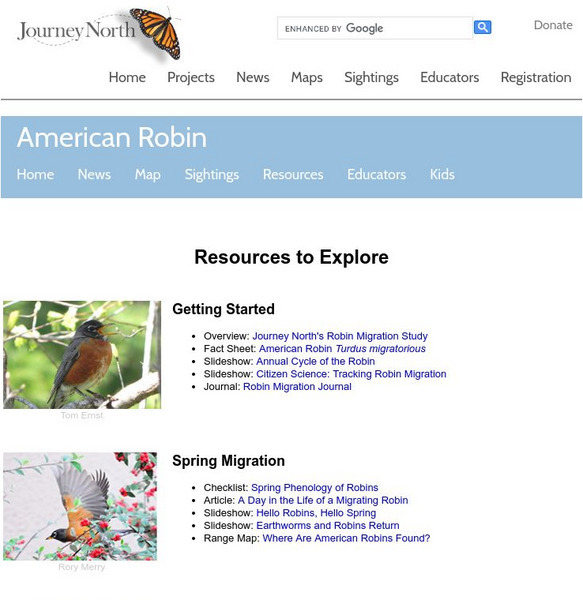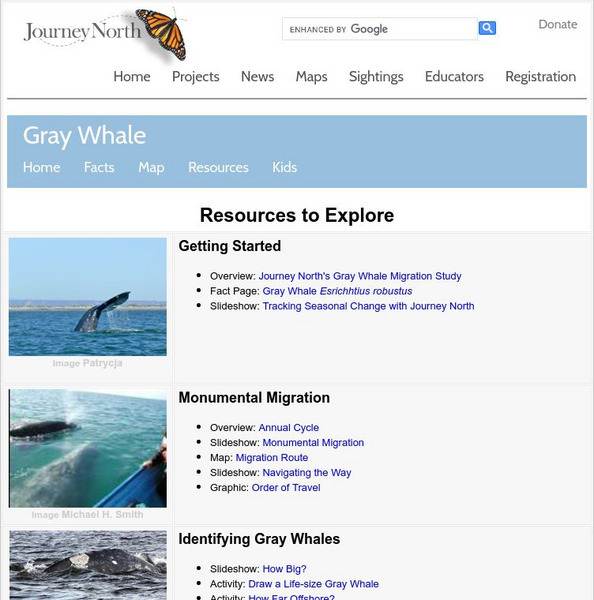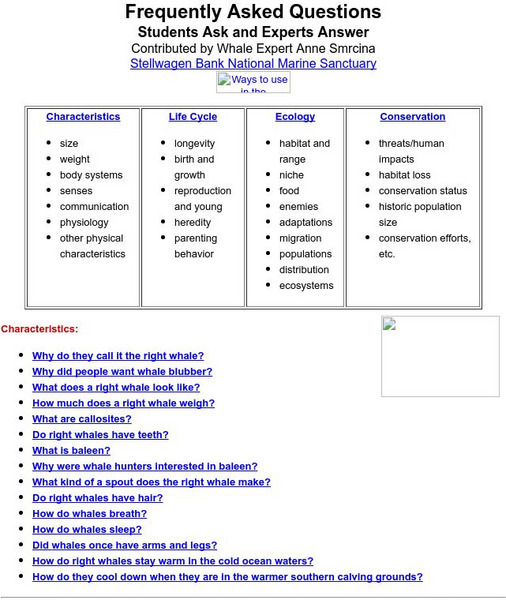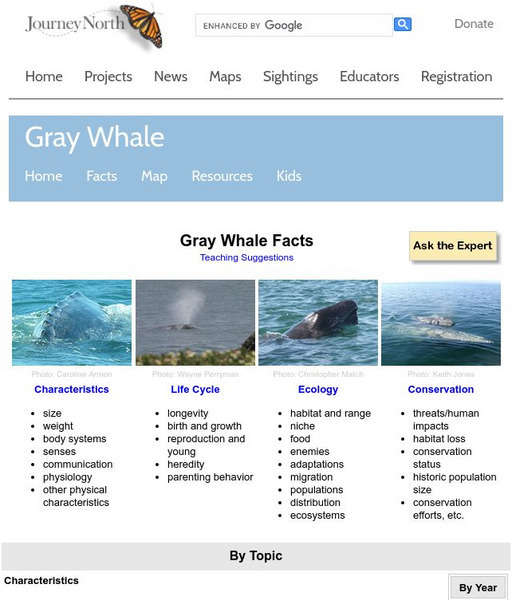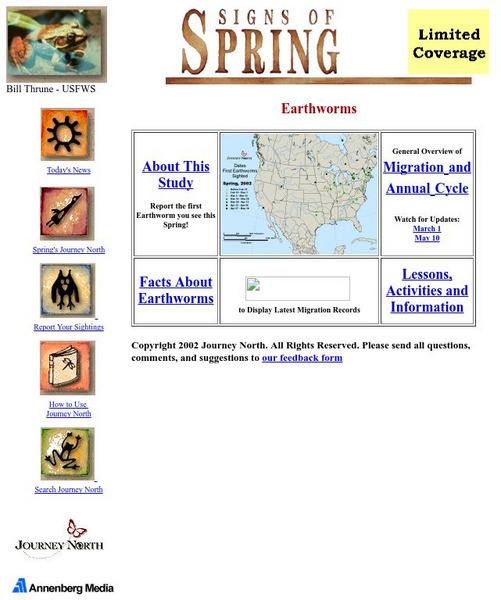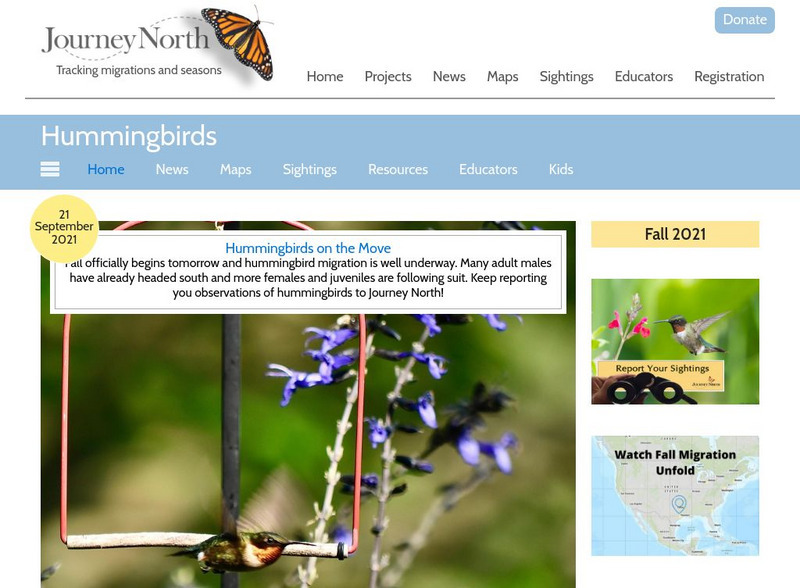Annenberg Foundation
Annenberg Learner: A Biography of America: World War Ii 1941 1945
Interactive feature deals with the morality of total war, and its effects on those who fought, died, and survived it, focusing on Japanese Americans living on the West Coast. Was the wartime internment of Japanese Americans appropriate?...
Annenberg Foundation
Annenberg Learner: Journey North: Monarch Butterfly: Journey North: Monarch Migration Update
Read and learn about monarch butterfly sightings and migration, and what those can tell about the species.
Annenberg Foundation
Annenberg Learner: Journey North: Hummingbird
Some resources helping students to learn all about the world of hummingbirds.
Annenberg Foundation
Annenberg Learner: Journey North: Tulip Test Gardens
A step-by-step guide to planting, growing and investigating with a garden full of tulips.
Annenberg Foundation
Annenberg Learner: Journey North: American Robin
Learn about the quintessential early birds, American Robins. Find out about their migration, nesting behavior, feeding, communication, and much more.
Annenberg Foundation
Annenberg Learner: Journey North: Gray Whales
Take a peek into Journey North's Gray Whale migration study. Learn about characteristics, migration, development, research, and conservation about these enormous marine mammals.
Annenberg Foundation
Annenberg Learner: Journey North: Whooping Crane
Look inside the lives of the beautiful whooping cranes. Learn about their characteristics, nesting behaviors, feeding, and the popular Ultralight-Led fall migration.
Annenberg Foundation
Annenberg Learner: Journey North: Sunlight and the Seasons
This student observation guide walks learners through setting up an investigation of the seasons and their causes. Students can report their actual data right there on the page.
Annenberg Foundation
Annenberg Learner: Journey North: Bald Eagle
Find out about the nesting behavior, physical characteristics, and feeding habits of bald eagles. Also, read about the history of the conservation efforts for the species.
Annenberg Foundation
Annenberg Learner: Journey North: Weather and Songbird Migration
Ornithologist Dr. David Aborn shares the secrets of weather and migration. Learn to read weather maps and predict when you will see songbirds traveling through your locale.
Annenberg Foundation
Annenberg Learner: Journey North: Signs of Spring: Earthworms
An informative presentation on earthworms that answers questions associated with ecology, conservation, life cycle, and characteristics.
Annenberg Foundation
Annenberg Learner: Journey North: Frequently Asked Questions About Bald Eagles
Questions and answers that touch on all the essentials about bald eagles (anatomy, reproduction and young, diet and feeding behaviors, migration and flight, habitat and range, and conservation).
Annenberg Foundation
Annenberg Learner: Journey North: Humpback Whales
A very informative article that answers questions related to characteristics of the humpback whale plus life cycle, ecology, behavioral adaptations and conservation. The migratory patterns of this whale are also tracked.
Annenberg Foundation
Annenberg Learner: Journey North: Right Whales
A comprehensive article that answers a number of questions about the right whale. Questions deal with characteristics, life cycle, ecology and conservation. This site also contains lessons and activities that can be used in the...
Annenberg Foundation
Annenberg Learner: Journey North: Gray Whales
A comprehensive presentation that answers a number of questions about gray whales. In addition, there are challenge questions, lessons, and activities that can be used in the classroom. the migratory pattern of this whale is also tracked.
Annenberg Foundation
Annenberg Learner: Journey North: Facts About Earthworms
A comprehensive resource on earthworms, offering the following sections: "Facts about Earthworms," "Migration and Annual Cycle," and "Lessons Activities and Information."
Annenberg Foundation
Annenberg Learner: Journey North: Caribou
A comprehensive resource that contains facts about caribou, challenge questions, lessons, activities and migration information. The migration pattern of the caribou is also tracked.
Annenberg Foundation
Annenberg Learner: Journey North: Oriole
A comprehensive resource that deals with the characteristics, life cycle, ecology, and conservation of the Oriole. In addition, there are lessons and activities that can be used in the classroom. The migration and annual cycle are also...
Annenberg Foundation
Annenberg Learner: Journey North: Adaptations: Fit for Survival
This lesson plan will help students explore adaptation, especially as it relates to migration. Students will come to realize that adaptations can be behavioral as well as physical. Students are assigned a particular animal to investigate...
Annenberg Foundation
Annenberg Learner: Journey North: Hummingbird
A comprehensive resource on hummingbirds, organized into the following sections: "How to Track Hummingbird Migration," "Migration Updates," "All About Hummingbirds," "Lessons, Activities, and Information," "Challenge Questions," and "Ask...
Annenberg Foundation
Annenberg Learner: Journey North: Whooping Cranes
Track the migration of whooping cranes, once on the verge of extinction. Follow new crane chicks from their hatching to the day they complete their first fall migration at 5 to 6 months of age.
Annenberg Foundation
Annenberg Learner: Journey North: Signs of Spring: Frogs
A comprehensive presentation that answers a number of questions about frogs. In addition, this resource contains lessons and activities that can be used in the classroom. A general overview is given of migration and the annual cycle.
Annenberg Foundation
Annenberg Learner: Journey North: Hummingbirds
Observe hummingbirds and report their sightings online. Share and review the sightings with other students/classrooms to track hemispheric migratory patterns.
Annenberg Foundation
Annenberg Learner: Journey North: Monarch Butterflies
Observe monarch butterflies and report their sightings online. Share and review the sightings with other students/classrooms to track hemispheric migratory patterns.




